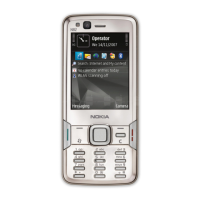Select Options > Advanced settings and from the
following:
● IPv4 settings — Enter the IP address of your
device, the subnet IP address, the default gateway,
and the IP addresses of the primary and secondary
DNS servers. Contact your internet service provider
for these addresses.
● IPv6 settings — Define the type of DNS address.
● Ad-hoc channel (only for Ad-hoc) — To enter a
channel number (1-11) manually, select User
defined.
● Proxy server address — Enter the address for the
proxy server.
● Proxy port number — Enter the proxy port
number.
Packet data settings
Press , and select Tools > Settings >
Connection > Packet data.
The packet data settings affect all access points using
a packet data connection.
● Packet data connection — If you select When
available and you are in a network that supports
packet data, the device registers to the packet data
network. Starting an active packet data connection
(for example, to send and receive e-mail) is quicker.
If there is no packet data coverage, the device
periodically tries to establish a packet data
connection. If you select When needed, the device
uses a packet data connection only if you start an
application or action that needs it.
● Access point — The access point name is needed
to use your device as a packet data modem to a
compatible computer.
● High speed packet access — Enable or disable the
use of HSDPA (network service) in UMTS networks.
Wireless LAN settings
Press , and select Tools > Settings >
Connection > Wireless LAN.
● Show WLAN availability — Select whether
is
displayed in the standby mode when a wireless LAN
is available.
● Scan for networks — If you set Show WLAN
availability to Yes, select how often the device
searches for available wireless LANs and updates
the indicator.
To view advanced settings, select Options >
Advanced settings. Changing wireless LAN advanced
settings is not recommended.
© 2007 Nokia. All rights reserved.150

